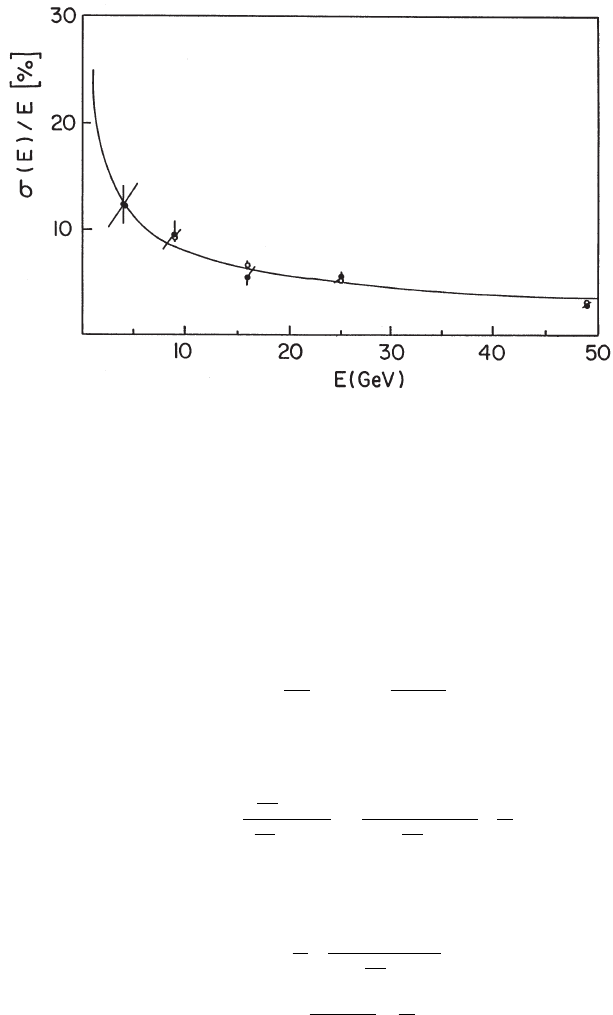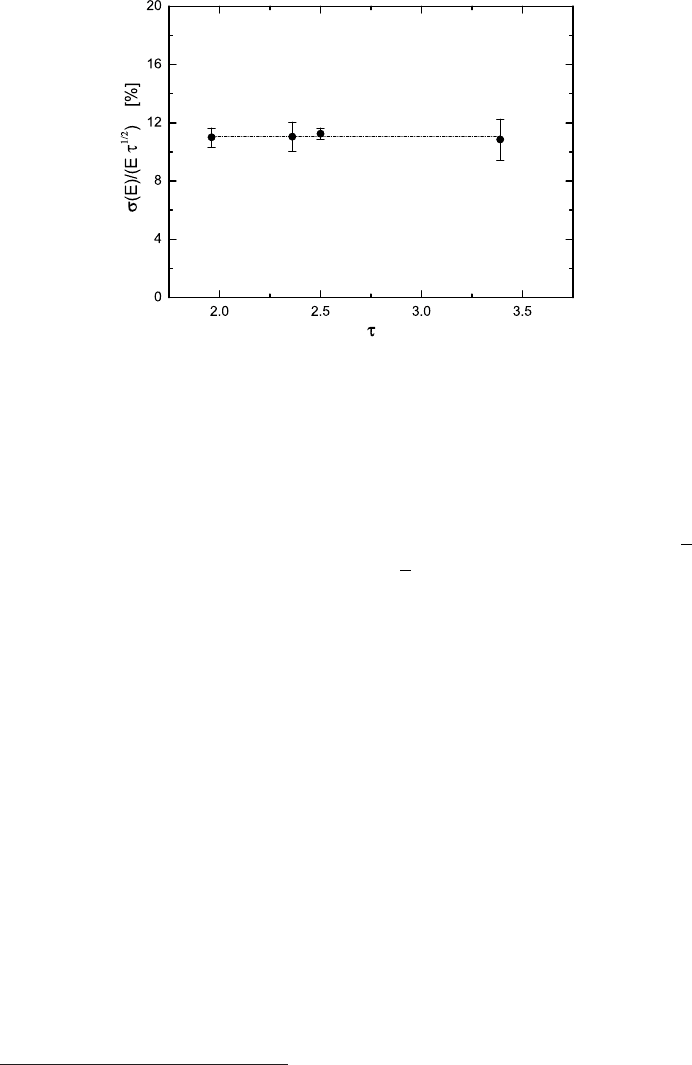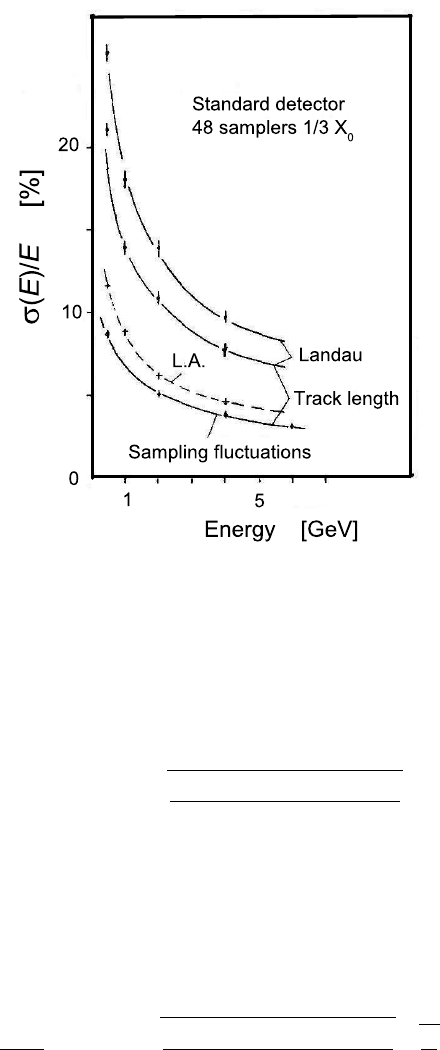Leroy C., Rancoita P.-G. Principles Of Radiation Interaction In Matter And Detection
Подождите немного. Документ загружается.


January 9, 2009 10:21 World Scientific Book - 9.75in x 6.5in ws-bo ok975x65˙n˙2nd˙Ed
640 Principles of Radiation Interaction in Matter and Detection
polyethylene foils with a thickness of the order of 1 cm. Studies, carried out by
Monte-Carlo simulations, have confirmed this possible use of low-A materials as
neutron moderators [Russ (1990); Russ et al. (1991)].
9.4 Energy Resolution in Sampling Electromagnetic Calorimetry
9.4.1 Visible Energy Fluctuations
The energy deposited in a sampling calorimeter is sampled and measured in a num-
ber of readout layers, which interspace the passive samplers. The energy deposition
is dominated by collision losses of positrons and electrons generated in the process
of energy degradation during the cascade development.
The energy deposited in active readout detectors fluctuates on an event-to-event
basis and is affected by the number and energy distribution of charged particles,
which do not usually cross the same amount of active samplers. At any depth in
a calorimeter, the fluctuation of the number of electrons and positrons is intrinsi-
cally related to the statistical nature of the cascade process. Therefore, the average
numb er of electrons and positrons traversing active samplers will undergo statisti-
cal fluctuations. Moreover, the collision loss stopping power of soft-energy electrons
(and positrons) is energy dependent. These particles deposit more energy than fast
electrons (or positrons) moving closer to the shower axis and are also more spread
laterally. Thus, the direction of average motion of soft charged particles makes large
angles with respect to the shower axis. Furthermore, because of the statistical nature
of the shower process, the cascade energy and spatial distributions are characterized
by fluctuations, i.e., deviations from their average behavior.
In sampling calorimeters, these fluctuations result in fluctuations of the sam-
pled visible-energy ²
vis
, i.e., in widening the distribution of the measured ²
vis
. They
are usually called energy sampling fluctuations [Amaldi (1981); Fabjan (1985a,
1986)]. As discussed above, this is related to the fluctuations in the number of par-
ticles and in the energy deposited by electrons and positrons traversing (or being
absorbed in) the active layers of the calorimeter.
The overall physical process of energy deposition in a medium is determined by
the mean energy deposition per charged particle traversing the active readout layers
multiplied by the average numb ers of particles N
cp
. To a first approximation, the
value of N
cp
can be estimated as:
N
cp
=
²
vis
E
el−loss
, (9.20)
where E
el−loss
is the collision energy-loss by electrons (or positrons, whose difference
can be neglected within our approximation) in a single active readout layer.
As discussed at page 200 and in Sect. 2.1.6, the electron collision energy-losses
are ≈ 10% larger than the collision energy-losses of a massive mip. In addition, in a

January 9, 2009 10:21 World Scientific Book - 9.75in x 6.5in ws-bo ok975x65˙n˙2nd˙Ed
Principles of Particle Energy Determination 641
Fig. 9.12 Energy resolution σ(E)/E in (%) versus E, data from the Si/W electromagnetic sam-
pling calorimeter of SICAPO Collaboration (Fig. 2.78) with τ = 2 (reprinted from Nucl. Instr.
and Meth. in Phys. Res. A 235, Barbiellini, G., Cecchet, G., Hemery, J.Y., Lemeilleur, F., Leroy,
C., Levman, G., Rancoita, P.G. and Seidman, A., Energy Resolution and Longitudinal Shower
Development in a Si/W Electromagnetic Calorimeter, 55–60, Copyright (1985), with permission
from Elsevier; see also [Leroy and Rancoita (2000)]).
shower generator medium, namely the passive sampler of the calorimeter, the mean
cosine value of the charged-particle opening-angle hcos θi is given by Eq. (2.253). In
the active readout layer of thickness X
S
, the average value E
el−loss
is given by
E
el−loss
≈ 1.1
µ
dE
dx
¶
S
X
S
µ
1
hcos θi
¶
. (9.21)
In a sampling calorimeter with a dominant passive sampler of thickness L
a
and
radiation length X
0a
, ²
vis
is given by Eq. (9.9) and using Eq. (9.21) one obtains
N
cp
= (e/mip)
"
¡
dE
dx
¢
S
X
S
¡
dE
dx
¢
a
X
0a
#"
hcos θi
1.1
¡
dE
dx
¢
S
X
S
#
E
τ
. (9.22)
As seen on page 200, the ratio ²
ca
/X
0a
is ≈ 1.1 (dE/dx)
a
, where ²
ca
is the critical
energy of the passive sampler. The previous equation can be finally written as:
N
cp
= (e/mip)
E
τ
"
hcos θi
1.1
¡
dE
dx
¢
a
X
0a
#
= (e/mip)
µ
hcos θi
10
−3
²
ca
¶
E
τ
, (9.23)
where the incoming particle energy E is in units of GeV, the critical energy of
the passive sampler, ²
ca
, is units of MeV and τ is the sampling frequency in units

January 9, 2009 10:21 World Scientific Book - 9.75in x 6.5in ws-bo ok975x65˙n˙2nd˙Ed
642 Principles of Radiation Interaction in Matter and Detection
of radiation lengths of the passive material. Assuming that the charged particles
are statistically independent [Amaldi (1981); Fabjan (1985a, 1986)], N
cp
is also the
value of the variance, i.e., the square value of the root mean squared (r.m.s.) error,
of the distribution of the number of charged particles.
So far, the measured mean value of the deposited energy in a sampling calorime-
ter has b een called visible energy (²
vis
), but fluctuations on its value have not
been considered. Owing to the intrinsic statistical character of the cascade phe-
nomenon (as discussed above), the energy distribution of ²
vis
, for incoming particles
of energy E, is a Gaussian distribution with standard deviation σ(²
vis
). One has
(e.g., see [Amaldi (1981); Fabjan (1985a, 1986)]):
σ(²
vis
)
²
vis
≈
1
p
N
cp
.
The energy resolution of the sampling calorimeter, σ(E)/E, on the incoming particle
energy E is
σ(E)
E
≡
σ(²
vis
)
²
vis
, (9.24)
and using Eq. (9.23), one obtains:
σ(E)
E
=
σ(²
vis
)
²
vis
≈
1
p
N
cp
= K
r
τ
E
. (9.25)
As in Eq. (9.23), τ is the sampling frequency in units of radiation length of the
passive material, the incoming particle energy, E, is in units of GeV and K is given
by
K =
s
10
−3
²
ca
(e/mip) hcos θi
≈ (3.16%)
r
²
ca
(e/mip) hcos θi
, (9.26)
where the passive sampler critical energy ²
ca
is in units of MeV.
Although Eq. (9.26) is similar to Equation 8 given by Amaldi (1981), the e/mip
ratio replaces the function of the minimum detectable energy F (ζ) (defined on page
201) in Eq. (9.26). In this equation, the e/mip ratio takes properly into account
the difference of the energy deposition per g/cm
2
between active readout layers and
passive samplers.
9.4.1.1 Calorimeter Energy Resolution for Dense Readout Detectors
Equation (9.26) was obtained under the assumption that electrons (and p ositrons)
depositing their energy by collision losses have similar statistical weights. This as-
sumption is acceptable for sufficiently thick dense active readout detectors, e.g., a
few cm of scintillator, so that the energy deposited by collision losses (for instance,
≈ 2 MeV/cm in scintillator) by fast charged particles moving forwards and close to
the shower axis are not negligible compared with the energy deposition by collision

January 9, 2009 10:21 World Scientific Book - 9.75in x 6.5in ws-bo ok975x65˙n˙2nd˙Ed
Principles of Particle Energy Determination 643
losses of laterally spread soft electrons. These soft particles have their energies not
exceeding a few MeV’s and can be fully absorbed.
However in thin (although dense) detectors, e.g. a few mm of liquid argon or a
few mm of scintillator or a few hundreds of microns of silicon detectors, particles
passing at large angle deposit much larger energy than those passing close to the
shower axis. As a consequence, N
cp
can be overestimated even by a factor 2, corre-
sponding to particles traversing (without being fully absorbed) at an angle of about
60
0
to the shower axis. This factor is reduced, when the mean traversing angle in-
creases. To a rough approximation, for a dense but thin readout detector, we can
assume that the N
cp
value given in Eq. (9.23) has to be multiplied by a reducing
factor 1/(1 + hcos θi). As already mentioned in the previous section, the mean cosine
value of the charged particle opening angle hcos θi is given by Eq. (2.253). Under
these approximations, the calorimeter energy resolution is again given by Eq. (9.25),
but the parameter K becomes:
K =
s
10
−3
²
ca
[1 + P
d
hcos θi]
(e/mip) hcos θi
≈ (3.16%)
s
²
ca
[1 + P
d
hcos θi]
(e/mip) hcos θi
, (9.27)
where the passive sampler critical energy ²
ca
is in units of MeV, and the parame-
ter P
d
is 0 for thick and dense readout layers [in this case, Eq. (9.27) transforms
into Eq. (9.26)] and 1 for thin and dense readout layers. Within the approxima-
tions used, Eq. (9.27) accounts for effects of differential collision energy-losses by
charged particles, impinging at different angles, traversing (or being absorbed in)
dense readout detectors. These effects are often referred to as path-length fluctu-
ations [Amaldi (1981); Fabjan (1985a, 1986)], and Landau fluctuations [Amaldi
(1981); Fabjan (1985a, 1986); Grupen (1996)]. These effects were introduced in the
sampling calorimetry to take into account the degradation of the energy resolution
because of the different path of large-angle particles (path-length fluctuations) and
large energy transfers in ionization process (Landau fluctuations). However, the lat-
ter fluctuations add a minor contribution to the deterioration of the calorimeter
energy resolution [Fabjan (1985a)].
In Eq. (9.27), the e/mip ratio depends on the Z values of the readout and ab-
sorber materials (see Sect. 9.2.2). Furthermore, the parameter K (as it is the case
for the energy and angular distributions of soft electrons) depends on the criti-
cal energy of the passive sampler. The calorimeter resolution σ(E)/E, for a fixed
sampling frequency and incoming particle energy, improves by increasing the visible-
energy sampled as long as sampling fluctuations are the major contribution to the
overall calorimeter resolution and both Landau and path length fluctuations can
be taken into account simply by the multiplicative factor discussed for Eq. (9.27).
Experimental data are in agreement with Eq. (9.25) predicting the energy resolu-
tion dependence on 1/
√
E. In Fig. 9.12, the energy resolution [SICAPO Collab.

January 9, 2009 10:21 World Scientific Book - 9.75in x 6.5in ws-bo ok975x65˙n˙2nd˙Ed
644 Principles of Radiation Interaction in Matter and Detection
Table 9.3 Selection of measured energy resolutions for sampling calorimeters with dense readout detectors from [Leroy and Rancoita (2000)]. Er-
rors are quoted when available in the original reference.
passive readout τ energy resolution K Reference
sampler at 1 GeV
(X
0
) (%) (%)
Al [see (1)] Scintillator ≈ 1 20.0 20.0 [Amaldi (1981); Fabjan (1985a)]
(marble) (3 cm) [see (1)] [Diddens et al. (1980)]
Fe Scintillator 1.4 23.0 19.4 [Abramowicz et al. (1981)]
Fe liquid Ar 8.5 × 10
−2
7.5 25.7 [Fabjan (1985a); Fabjan et al. (1977)]
Fe Si det. 2.0 32.2±1.1 22.8±0.8 [SICAPO Collab. (1994a)]
W Si det. 2.0 24.6±0.4 17.6±0.3 [SICAPO Collab. (1985a)]
Pb Scintillator 1.8 × 10
−1
7.5 17.7 [Hofmann et al. (1979)]
Pb Scintillator 2.1 × 10
−1
9.0 19.4 [Schneegans et al. (1982)]
Pb Scintillator 1.8 23.5±0.5 17.6±0.4 [Drews et al. (1990)]
Pb liquid Ar 3.1 × 10
−1
[see(2)] >20 GeV 14.4 [Buckardt et al. (1988)]
Pb Si det. 0.9 16.5±0.5 17.4±0.5 [Nakamoto et al. (1985)]
Pb liquid Ar 3.2 × 10
−1
Accordion 9.6 − 10.1 16.9-17.8 [Aubert et al. (1991)]
U Scintillator 0.5 11.0 15.6 [Carosi et al. (1984)]
U Scintillator 1 16.5±0.5 16.5±0.5 [Drews et al. (1990)]
(1): it means that the marble used as passive sampler is equivalent to Al. The scintillator used as readout is 3 cm thick.
(2): the energy resolution is given by:
σ(E)
E
=
r
¡
0.1
E
¢
2
+
³
0.075
√
E
´
2
+ (0.005)
2
.

January 9, 2009 10:21 World Scientific Book - 9.75in x 6.5in ws-bo ok975x65˙n˙2nd˙Ed
Principles of Particle Energy Determination 645
Fig. 9.13 σ(E)/(Eτ
1/2
) (in %) measured for Pb absorbers versus τ at the incoming energy of
4 GeV (data from [SICAPO Collab. (1994a)]). The line is the weighted mean of the data values.
(1985a)] of a sampling calorimeter with tungsten sampler thicknesses of 2 X
0
and
silicon readout detectors is shown for incoming electron energies between 4 and
49 GeV. The energy resolution is well represented by the fitted curve following
Eq. (9.25) [SICAPO Collab. (1985a)].
At fixed energy, Eq. (9.25) predicts that the energy resolution depends on
√
τ. In
Fig. 9.13, the energy resolution divided by
√
τ, i.e., σ(E)/(Eτ
1/2
) in %, is shown
as a function of τ, for electrons of 4 GeV energy and passive samplers made of Pb
plates [SICAPO Collab. (1994a)]. The values of σ(E)/(Eτ
1/2
) do not depend on τ,
as expected from Eq. (9.25).
A summary of experimental data on electromagnetic sampling calorimeters using
dense readout detectors (namely silicon detectors, scintillators and liquid argon
ionization chambers) is presented in Table 9.3. Reported data include the type of
readout detector, the sampling frequency τ, the measured energy resolution fitted
by Eq. (9.25) and evaluated at 1 GeV of incoming electron energy, and the pa-
rameter K. The experimental energy resolutions are measured by employing low-
(Al), medium- (Fe), and high-Z (W, Pb, U) passive samplers, which are the most
frequently used absorbers. The sampling frequency varies between ≈ 9 × 10
−2
and
2. However, in spite of experimental uncertainties and different calorimeter para-
meters, for a given type of passive sampler the values of K do not differ by more
than ≈ 10% from their mean values. These averages of experimental K values, for
calorimeters using the same passive samplers, are shown in Table 9.4 together with
the K values calculated by means of Eq. (9.27). In Table 9.4, the e/mip ratios were
estimated by averaging the experimental data
¶
shown in Table 9.1. The agreement
among estimated and averaged experimental K values (shown in Table 9.4) is sati-
¶
The same value of Pb sampler was assumed for W absorber.

January 9, 2009 10:21 World Scientific Book - 9.75in x 6.5in ws-bo ok975x65˙n˙2nd˙Ed
646 Principles of Radiation Interaction in Matter and Detection
sfactory and indicates that Eqs. (9.25, 9.27) take well into account the fluctuations
of the visible energy for dense readout detectors. So far, it was assumed, in the
comparison of experimental data with predictions, that the intrinsic statistical fluc-
tuations are the limiting constraints on the calorimeter energy resolution. In a real
detector, many instrumental effects add to these statistical fluctuations and worsen
the energy resolution. They depend on the type of device (sampling or homogeneous
calorimeter) and readout medium. The instrumental noise, detection statistics and
intercalibration errors affect the overall energy resolution and, particularly, limit
the detector performance at high energies. In [Engler (1985)] and references therein,
their influence on calorimeter resolution is treated in a general way. Furthermore in
Sect. 9.4.2, the degradation of the calorimeter resolution induced by visible-energy
losses, due to the finite dimensions of the device, is evaluated.
9.4.1.2 Calorimeter Energy Resolution for Gas Readout Detectors
Sampling calorimeters were also built with gas detectors as active readout de-
vices. As discussed in the previous section, the wide spread of electron angles is
among the causes of degradation of the calorimeter energy resolution. These path-
length fluctuations depend on the thickness of readout detectors, namely they in-
crease as the thickness decreases (as discussed above). In the same way, Landau
fluctuations [as shown by Amaldi (1981) in Equation 21] are larger for calorimeters
in which the deposited energy is measured. However, in calorimeters using streamer-
tubes as readout detectors, tracks are counted at least as long as the particles are
close to the shower axis. For each ionization track one streamer is formed and,
consequently, Landau fluctuations affect less the energy resolution.
In general, these fluctuations cannot be neglected, when gas detectors are used
as active readout samplers. The energy resolutions of multiwire proportional quan-
tameters were investigated by means of Monte-Carlo simulations [Fisher (1978)]
and compared with experimental data. Fisher (1978) has shown, see Fig. 9.14, that
path length (also termed track length) and Landau fluctuations worsen the sampling
fluctuations in these quantameters [Fisher (1978)] by a factor ≈ 2. The energy re-
solutions obtained using Monte-Carlo simulations were found to agree with those
measured with Pb [Nordberg (1971)] and Fe [Anderson et al. (1976)] gas quan-
tameters [Fisher (1978)]. Measured energy resolutions of calorimeters employing
gas readout detectors are given for Fe and Pb passive samplers in Table 9.5. The
average measured K values for Fe and Pb absorbers are 32% and 26%, respecti-
vely. Although the gas readout detectors are operated in different way, the mea-
sured K values do not differ by more than ≈ 15% from their respective average
values. These average values, in turn, are in agreement with K-parameters derived
from Eq. (9.27) (see Table 9.4) once multiplied by a factor ≈
√
2. This factor can
be taken into account empirically in Eqs. (9.26, 9.27). For a gas calorimeter (within

January 9, 2009 10:21 World Scientific Book - 9.75in x 6.5in ws-bo ok975x65˙n˙2nd˙Ed
Principles of Particle Energy Determination 647
Table 9.4 Comparison of K values from measured energy resolutions and calculated by means of Eq. (9.27)
from [Leroy and Rancoita (2000)].
passive readout (e/mip) hcos θi K K
sampler [see(1)] from Eq. (2.253) from Eq. (9.27) experim. [see(2)]
(%) (%)
Al [see(3)] thick 1.00 0.986 20.2 20.0
(marble)
Fe thin 0.83 0.949 22.8 22.6
W thin 0.66 0.671 17.4 17.6
Pb thin 0.66 0.614 17.2 17.3
U thin 0.63 0.543 17.5 16.1
(1): average values from data of Table 9.1; it was assumed that W and Pb have equal (e/mip) ratios.
(2): average values from data of Table 9.3.
(3): it means that the marble used as passive sampler is equivalent to Al.

January 9, 2009 10:21 World Scientific Book - 9.75in x 6.5in ws-bo ok975x65˙n˙2nd˙Ed
648 Principles of Radiation Interaction in Matter and Detection
Fig. 9.14 Contributions of sampling, track length (also termed path length) and Landau fluc-
tuations to the energy resolution of a Pb gas quantameter as computed by Fisher (1978) (see
also [Amaldi (1981); Leroy and Rancoita (2000)]), using Monte-Carlo simulations (adapted
from Nucl. Instr. and Meth. 156, Fisher, H.G., Multiwire Proportional Quantameters, 81–85,
Copyright (1978), with permission from Elsevier). The curve labeled “L.A.” regards the expected
resolution for a liquid argon calorimeter (for details see [Fisher (1978)]).
an approximation of ≈ 15%), one has
K ≈ (3.16%)
s
²
ca
(1 + P
d
hcos θi)(1 + P
g
)
(e/mip) hcos θi
, (9.28)
where ²
ca
is the critical energy of the passive sampler in units of MeV, hcos θi is given
by Eq. (2.253); the parameter P
d
is 0 for thick and dense readout layers [in this case,
Eq. (9.28) transforms into Eq. (9.26)] and 1 for thin and dense readout layers [in
this case Eq. (9.28) transforms into Eq. (9.27)]. In both cases, the parameter P
g
is
0. For sampling calorimeters with gas readout detectors, the parameters P
g
and P
d
are both equal to 1. Then, the energy resolution of an electromagnetic calorimeter
can be finally written as
σ(E)
E
≈ (3.16%)
s
²
ca
(1 + P
d
hcos θi)(1 + P
g
)
(e/mip) hcos θi
r
τ
E
. (9.29)

January 9, 2009 10:21 World Scientific Book - 9.75in x 6.5in ws-bo ok975x65˙n˙2nd˙Ed
Principles of Particle Energy Determination 649
Table 9.5 Selection of measured energy resolutions for sampling calorimeters with gas readout detectors from [Leroy and Rancoita
(2000)]. Errors are quoted when available in the original reference.
passive readout τ energy resolution K Reference
sampler at 1 GeV
(X
0
) (%) (%)
Fe MWPC 1.6 ≈ 47.2 ≈ 37.4 [Fisher (1978)],[Anderson et al. (1976)]
Fe streamer mode 1.2 28.8 26.4 [Baumgart (1987); Baumgart et al. (1988a)]
Fe streamer mode 2.8 55.0 32.6 [Catanesi et al. (1986)]
Pb MWPC 5.6 × 10
−1
≈ 20.6 ≈ 27.6 [Fisher (1978); Nordberg (1971)]
Pb saturated prop.-mode 0.5 16.2 22.9 [Atac et al. (1983)]
Pb saturated prop.-mode 3.6 × 10
−1
16.5 27.6 [Videau et al. (1984)]
